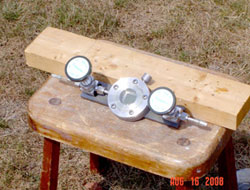CO2 + steam = gas
According to inventor Craig Grimes at the University of Pennsylvania (USA), the removal of CO 2 from the atmosphere (to reduce the impact on the Earth's climate) and turning this greenhouse gas into a fuel today It is no longer impossible.

Photo: Phyorg.com
Craig and his colleagues invented a device that contains a nanotube system capable of converting a mixture of CO2 and water vapor into natural gas. This device offers a new way of reducing the amount of carbon dioxide in the atmosphere and turning it into fuel or other chemicals to limit the effects of greenhouse gases - formed from combustion. Fossil fuels - for global climate.
Previously, many research groups used to convert CO2 into organic compounds such as methane, using titanium dioxide nanoparticles as catalysts. However, older methods require the use of ultraviolet light as energy to serve reactions. Meanwhile, Craig's group uses sunlight as an energy source. Craig and colleagues discovered they could increase the catalytic capacity of titanium dioxide by turning it into nanotubes with each tube about 135 nanometers (1 nanometer = 1 part per cent) in diameter and 40 microns long (1 micron = 1 millionth of a meter). This increases the surface area of titanium dioxide. And yet, coating a layer of platinum and copper onto nanotubes also increases the catalytic ability of titanium dioxide.
After being processed, titanium dioxide nanotubes are placed in a metal box with a quartz gap. Then, Craig and his crew pumped into the nanotubes mixture of CO2 and steam, and placed the metal box under sunlight for 3 hours (photo). The energy from sunlight converted CO2 and water vapor into methane and group organic mixtures such as ethane and propane with 160 microlit / hour efficiency per gram of nanotubes (1 microlit = 1 parts per million liters).
The transformation efficiency is 20 times higher than the results obtained using previous methods (using ultraviolet light as a catalyst). However, it is still not high enough to be able to carry out production on a commercial scale. Craig suggested that his team is working to add a copper nanoparticle to titanium dioxide nanotubes - this way has the potential to significantly increase the efficiency of converting CO2 and water vapor into gas.
- Create steam using nanotechnology
- The smallest steam engine in the world
- Steam train in Kingston
- Does the 'air conditioner' fan really regulate?
- The device absorbs sunlight to create superheated steam
- Steam Cleaning - technology used to clean Ngo Mon Gate of Hue Citadel
- James Watt - Ideas & career
- The stratospheric steam changes the global temperature
- Again detected steam at Fukushima power plant
- Detection of steam emitted from dwarf planet Ceres
- The engine runs in the air
- Explain the danger that happens when pouring hot copper into an iceberg
 Daily use inventions come from universities
Daily use inventions come from universities Special weight loss device helps prevent appetite
Special weight loss device helps prevent appetite 8 inventors were killed by their own inventions
8 inventors were killed by their own inventions Iran invented a motor car powered by water
Iran invented a motor car powered by water